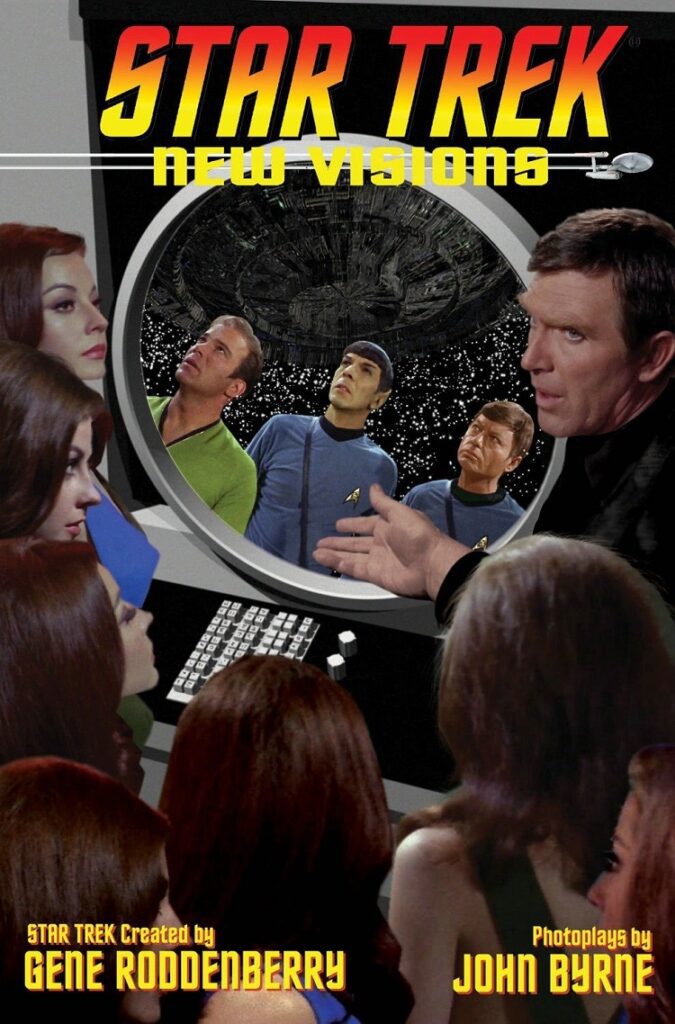
Growing up in the ‘70s and early ‘80s, before VCRs became commonplace in households, we were limited to the whims of TV station programmers when it came to watching our favorite shows, unlike viewers today who have instant access and can even own copies of them. To revisit Star Trek at one’s leisure in those bygone days, the options were limited. James Blish adapted episodes into short-story collections, and industrious fans recorded shows off the TV onto cassette tapes, listening to them like a radio broadcast.
Twelve episodes, selected from all three seasons, were given the photonovel treatment so fans could see the stories play out like a comic book through the use of images from the show combined with captions and speech balloons. Currently, John Byrne uses the photonovel method to tell all-new adventures from the five-year mission of the Starship Enterprise under the command of Capt James T. Kirk in IDW’s Star Trek: New Visions. Volume Three collects Issues #6-8.
In “Resistance” the Enterprise encounters an unknown, vicious enemy that callously destroys planets through forced core explosions. While the ruthless aliens’ identity remains a mystery to Kirk and the crew as the story ends, readers, especially fans of The Next Generation, will know them from the hints Byrne provides such as their originating from the Delta Quadrant and the three words repeated in the signal they transmit.
Kirk uses the Guardian of the Forever to return to 20th Century Earth in “1971/4860.2” to seek out the help of Gary Seven, from the episode “Assignment: Earth.” They team up to take on a few Dhoraxi who have altered the timeline and caused the Enterprise and its crew to vanish from existence. Meanwhile, Spock and Scotty have to deal with their sabotaged spaceship.
When Kirk and McCoy take shore leave on Wrigley’s Pleasure Planet in “The Survival Equation,” they discover someone is using the computers on the planet Exo III to create duplicates of Dr. Roger Korby’s gorgeous android Andrea from “What Are Little Girls Made Of?” That someone is a very familiar face, who hasn’t thought through all the implications and just presumes all the androids will be loyal to him, as did Korby.
Although Byrne acknowledges the limitations of the art in his introduction, those new to this book series should be aware there are noticeable flaws. Faces of modern-day actors and CGI effects don’t blend well with the TV-series images. Eye lines don’t always line up. Hairstyles as well as the colors of faces and uniforms aren’t consistent from panel to panel. The most glaring example is in “Resistance.” Kirk wears his alternative green tunic the vast majority of the time, but on multiple occasions, Byrne uses images of Kirk in his traditional gold. In one instance, he even pastes a portion of Kirk’s chest from one image onto another.
But the art issues are a minor quibble because the stories are so fantastic. Byrne’s photoplays continue to be very entertaining because his writing demonstrates he has a strong sense of who the characters are and the way they should behave. Like the best episodes of the Original Series, the conflicts are believable, the stakes are high, yet there are also moments of humor. Plus, it’s enjoyable to see characters and references from past episodes. I highly recommend Byrne’s New Visions to any Star Trek fan